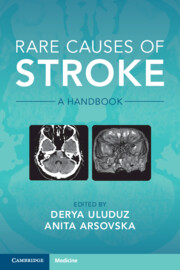Book contents
- Rare Causes of Stroke
- Rare Causes of Stroke
- Copyright page
- Contents
- Contributors
- Preface
- 1 Inflammatory Conditions
- 2 Infectious and Postinfectious Vasculitis
- Chapter 2.1 Meningovascular Syphilis
- Chapter 2.2 Neuroborreliosis
- Chapter 2.3 Tuberculosis Meningitis
- Chapter 2.4 Bacterial Meningitis
- Chapter 2.5 Neurocysticercosis
- Chapter 2.6 Varicella-Zoster Virus-Related: Cytomegalovirus (CMV) and Herpes Infections
- Chapter 2.7 HIV Infection
- Chapter 2.8 Chagas Disease
- 3 Hypercoagulable Causes of Stroke
- 4 Drug-Related Stroke
- 5 Hereditary and Genetic Causes of Stroke
- 6 Rare Causes of Cardioembolism
- 7 Vasospastic Conditions and Other Vasculopathies
- 8 Other Non-inflammatory Vasculopathies
- 9 Venous Occlusive Conditions
- 10 Bone Disorders and Stroke
- Index
- References
Chapter 2.5 - Neurocysticercosis
from 2 - Infectious and Postinfectious Vasculitis
Published online by Cambridge University Press: 06 October 2022
- Rare Causes of Stroke
- Rare Causes of Stroke
- Copyright page
- Contents
- Contributors
- Preface
- 1 Inflammatory Conditions
- 2 Infectious and Postinfectious Vasculitis
- Chapter 2.1 Meningovascular Syphilis
- Chapter 2.2 Neuroborreliosis
- Chapter 2.3 Tuberculosis Meningitis
- Chapter 2.4 Bacterial Meningitis
- Chapter 2.5 Neurocysticercosis
- Chapter 2.6 Varicella-Zoster Virus-Related: Cytomegalovirus (CMV) and Herpes Infections
- Chapter 2.7 HIV Infection
- Chapter 2.8 Chagas Disease
- 3 Hypercoagulable Causes of Stroke
- 4 Drug-Related Stroke
- 5 Hereditary and Genetic Causes of Stroke
- 6 Rare Causes of Cardioembolism
- 7 Vasospastic Conditions and Other Vasculopathies
- 8 Other Non-inflammatory Vasculopathies
- 9 Venous Occlusive Conditions
- 10 Bone Disorders and Stroke
- Index
- References
Summary
Neurocysticercosis (NCC) is the infection of CNS by the larval stage of the Taenia Solium, a tapeworm that infests humans in endemic zones (Latin American countries, sub-Saharan Africa, China, India, southeast Asia) NCC has a wide range of clinical manifestations but the most common are seizure and increase intracranial pressure. Focal neurological deficits are also possible due to oedema around cysts or mass effects of cysticerci. Patients could also experience ischemic stroke due to occlusion of the intracranial arteries or brainstem involvement. Patients with stroke and NCC that live in rural areas could be identified after a long period of time from the acute event and this delay could be responsible for a spontaneous resolution of the lesion detectable through MRI (3).Thus, routine corticosteroid administration is mandatory in patients with subarachnoid cysts, to avoid the risk of cerebral infarction. Here we reported a case of a 34 year-old woman presented to ED with headache that gradually become more severe over the past couple of weeks. Serological test enzyme-linked immunoelectrotransfer blot (EITB) was positive for antibodies to Taenia Solium so diagnosis of NCC was made. She started anti-inflammatory therapy with dexamethasone and later levetiracetam 500 mg twice daily with full recovery
- Type
- Chapter
- Information
- Rare Causes of StrokeA Handbook, pp. 132 - 136Publisher: Cambridge University PressPrint publication year: 2022



